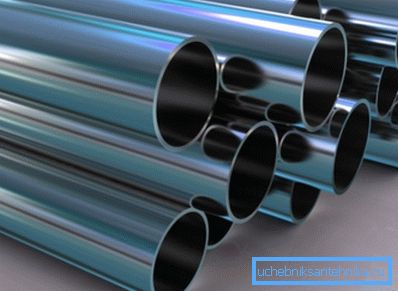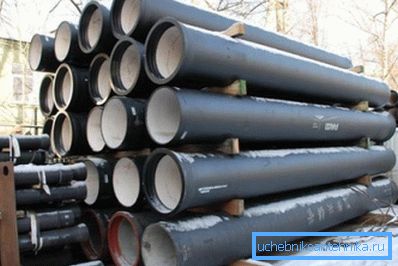Round tube - types and features
Round pipes are a widespread building material, which is used when laying pipelines, erecting various metal structures, foundations, etc. They are made of various types of metals and plastic. Next we look at the most common types of round tubes and their features.

General information
Surely, many wondered why round pipes are used in all types of pipelines?
This is due to the following advantages of the cylindrical shape:
- If you roll a steel sheet (billet), so that its two edges touch, it will be a pipe and a round shape. It follows that products of this form are the easiest to manufacture.
- This form ensures the best resistance of the system to external and internal pressure..
- Minimum surface at maximum internal volume. Thus, with a fixed pipeline, a minimum of material is spent. In addition, the hydraulic resistance is reduced when transporting liquids.
- Minimal surface provides minimal heat loss.. This is especially important in heating systems.

I must say that there are also disadvantages associated with the cylindrical shape of the products:
- Since there is no plane, docking with other structural elements is associated with certain difficulties, regardless of the type of installation.
- Low bending strength.
For this reason, the products in question are extremely rarely used in the assembly of metal structures.
Tip! As structural parts, it is much more expedient to use profile products - square or rectangular.
Kinds
The range of round tubes is incredibly extensive. In the first place, products differ in the type of material from which they are made.
Thus, when installing different types of pipelines, a different pipe can be used - a table with the main types of these products is given below:
| Steel | They are one of the most common materials used in gas pipelines, water mains and other systems. |
| Cast iron | Most often are used when laying water supply systems and external sewer systems. |
| Plastic | Include a whole group of different materials that are used in the installation of water pipes, sewer systems, gas pipelines, as well as heating systems. |
Now take a closer look at the features of each of their species.

Steel
Among the advantages of these products are several highlights:
- Strength;
- Plastic;
- Resistance to mechanical stress;
- Frost resistance;
- Resistance to high temperatures.
As a result, steel pipe products, despite the fact that a lot of new materials have appeared on the market, are still widely used in a variety of applications.
However, along with the advantages, it has some disadvantages:
- Big weight that complicates installation and transportation of products. It should be noted that the weight of a round pipe depends on the wall thickness. Therefore, the stronger the material, the greater its mass.
- High cost compared to plastic products.
- Susceptibility to corrosion, so the pipeline needs corrosion protection. I must say that galvanized pipes made according to GOST 10704 91 are practically devoid of this shortcoming.
All steel pipes differ in manufacturing method.
They can be:
- Welded, which in turn are divided into:
- Straight-seam, production of which is regulated by GOST 10704-91,
- Spiraleshovny which make in accordance with GOST 8696-74.

On the type of production depend on the performance of products. For example, seamless are able to withstand more pressure, however, their walls are thicker, and they weigh, respectively, more.
Note! Before laying the steel pipeline, it may be necessary to calculate the weight of the round pipe. This will allow you to correctly calculate the strength of supports and fasteners. However, in most cases, you can find out the weight of the material from the references.

Cast iron
Not so long ago, this type of pipe products was widely distributed during the installation of internal sewer systems. However, due to their large weight, relatively high cost and complexity of installation, recently they have given way to plastic counterparts. But in the systems of external plumbing and outdoor sewage systems are widely used to this day.
Their use is particularly justified in cases where the pipeline is subjected to a large external pressure, and at the same time high demands are placed on it with respect to corrosion resistance.

Plastic
When installing domestic pipelines are increasingly using plastic materials.
This is due to a number of their positive properties:
- Corrosion resistance;
- Durability;
- Easy installation, so you can do it yourself;
- Sufficient strength;
- Low weight;
- Low price, compared with steel counterparts;
- Low thermal conductivity.
As for the shortcomings, these include:
- Lower strength, compared with steel counterparts;
- Low frost resistance;
- Exposure to sunlight, etc.

This product differs in the type of material from which it is made.
The most popular are the following types of products:
- Polypropylene;
- Polyvinyl chloride;
- Polyethylene.
I must say that depending on the destination, the diameter of the products can be very different. For example, the dimensions of a round pipe according to GOST 52134 (for pipes from thermoplastics) can be from 10 mm to 1600 mm.
Installation instructions for plastic pipelines also depend on the type of material and its purpose.
A connection can be made in three ways:
- By welding (cold or hot);
- Threaded or threaded pipe fittings;
- Flared method using seals.
Here, perhaps, are all the main types and features of round pipes.
Conclusion
The use of round pipes in pipelines is justified by several reasons, which are given above. Since there are a great many different types of pipelines, the materials for their installation are also very different. From this it follows that in each individual case they should be selected in accordance with the tasks set for them.
From the video in this article, you can get more information on this topic.